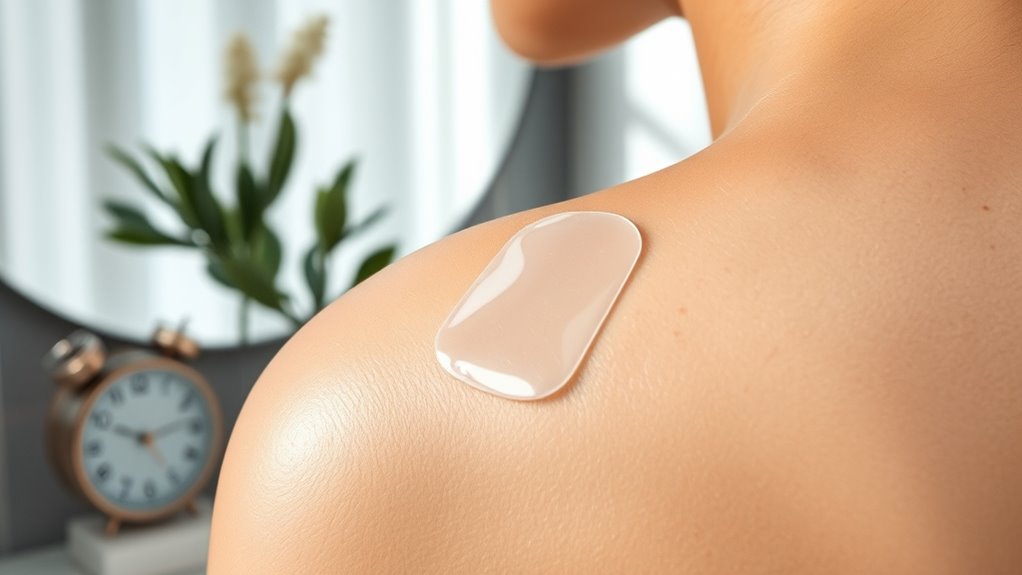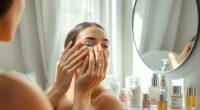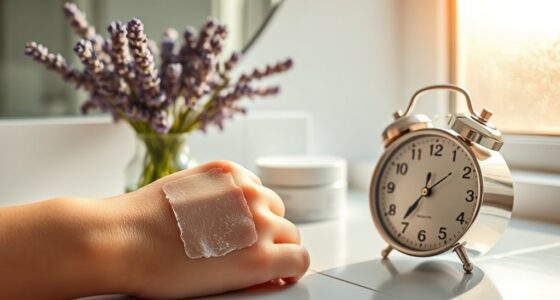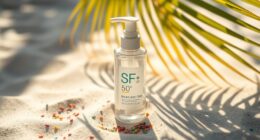To get the best results from your pimple patch, leave it on for 6 to 12 hours. This duration allows for maximum absorption, helping to heal your blemishes effectively. If you notice the patch turning white or cloudy, it’s time to replace it, as that means it’s saturated. For sensitive skin, a shorter wear time may be better. Stick around to discover more tips on using pimple patches effectively and customizing the experience for your skin type.
Key Takeaways
- The optimal duration for wearing pimple patches is between 6 to 12 hours for effective results.
- For sensitive skin, it’s recommended to wear patches for 4 to 6 hours to avoid irritation.
- Patches should be replaced once they turn white or cloudy, indicating they are saturated.
- Overnight application can enhance healing while providing a protective barrier against bacteria.
- Ensure the skin is clean and dry before application to maximize patch adhesion and effectiveness.
Understanding Pimple Patches and Their Purpose
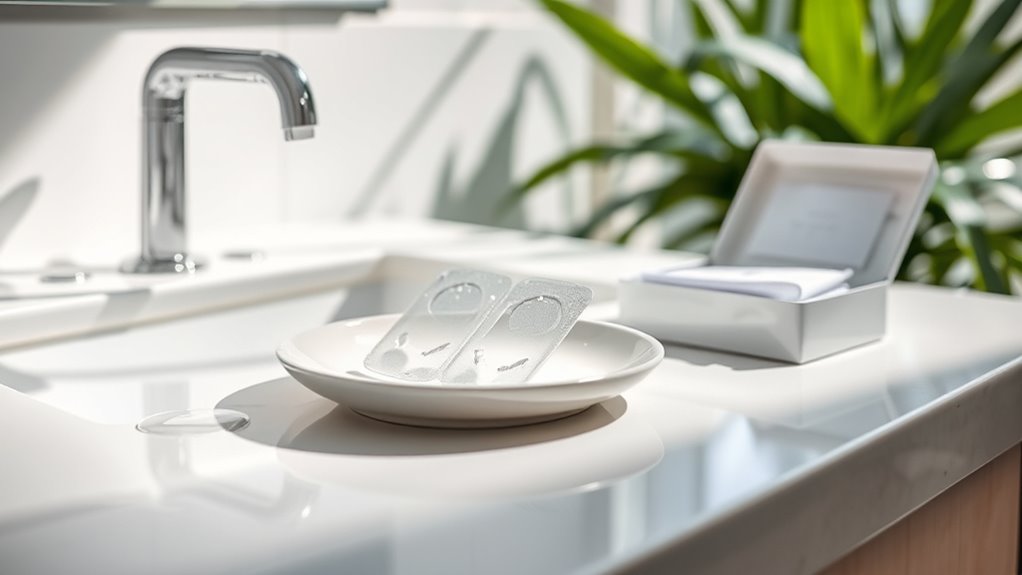
When you’re dealing with a pimple, understanding pimple patches and their purpose can make a significant difference in your skincare routine.
These patches, often made from hydrocolloid, create a protective barrier that absorbs excess fluids and shields your skin from irritants. Many patches also contain active ingredients like salicylic acid or tea tree oil, providing extra benefits. This technology is based on established medical practices for treating wounds, ensuring effective results in acne management.
Their thin, transparent design makes them discreet enough for daytime wear, so you can treat blemishes without drawing attention. By keeping the area moist, pimple patches promote faster healing while preventing you from picking or squeezing, reducing the risk of scarring.
Incorporating these patches into your routine can enhance your overall skincare effectiveness and help maintain your skin’s health.
Recommended Duration for Standard Use

Using pimple patches effectively requires knowing how long to keep them on for best results. Most hydrocolloid patches work best when you leave them on for 4 to 8 hours. This timeframe allows the patch to absorb impurities, reducing inflammation and promoting healing. Hydrocolloid technology creates a protective barrier over blemishes, enhancing the patch’s effectiveness during this period.
You’ll know it’s time to remove the patch when it turns white or cloudy, indicating maximum absorption. Make sure your skin is clean and dry before applying the patch for ideal adhesion. If the patch comes loose or falls off, replace it with a new one after cleansing the area.
For whiteheads, aim for the full 6-8 hours, while those with sensitive skin might prefer shorter durations to avoid irritation.
Benefits of Overnight Application
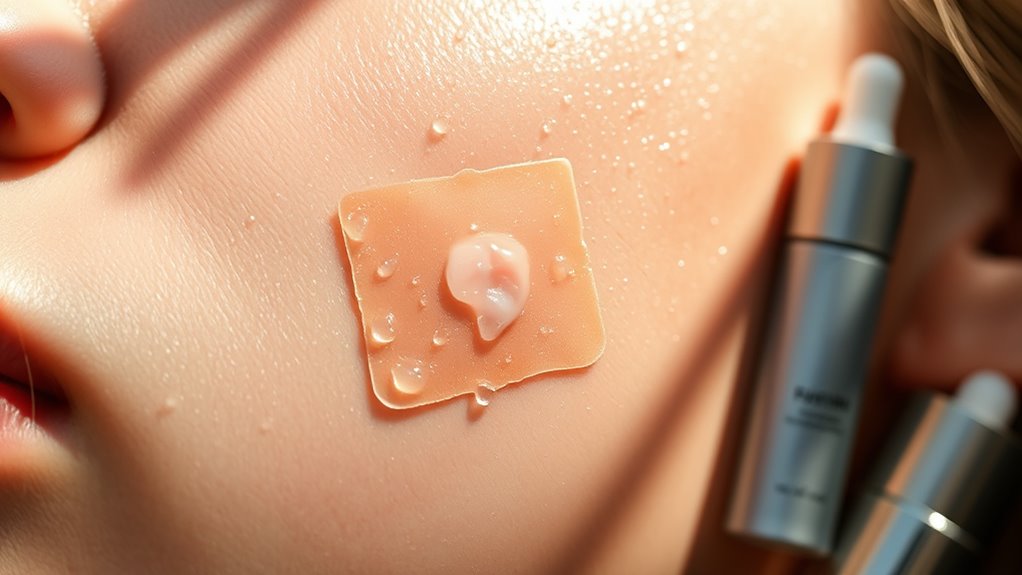
Applying a pimple patch overnight can markedly enhance its effectiveness, as it allows the patch to work uninterrupted while you sleep. This method speeds up the healing process by creating a moist environment that promotes recovery. Additionally, it helps reduce redness and swelling, calming inflammation for a more even skin tone by morning. The patch acts as a barrier, preventing you from picking at the pimple, which can lead to scars. It also protects against bacteria, keeping the area clean and minimizing the risk of infection. Furthermore, optimal wear time is typically 8–10 hours, which aligns perfectly with overnight use. Plus, it’s convenient—you get treatment while you rest, making it an easy addition to your nighttime routine. You’ll wake up to clearer, healthier-looking skin, boosting your confidence for the day ahead.
Exploring Extended Wear Options
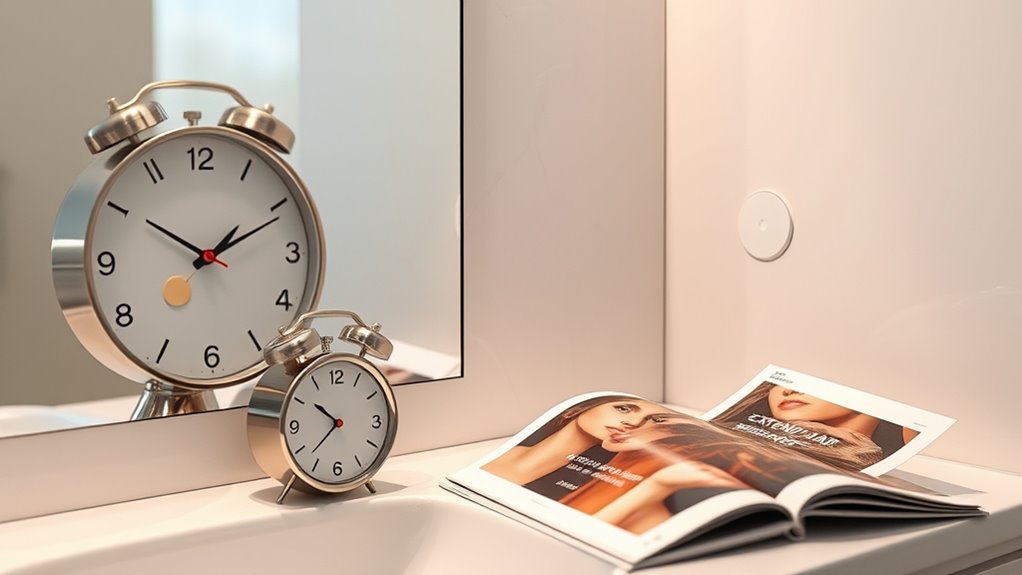
As you consider your options for extended wear, it’s essential to understand the variety of pimple patches available and their specific benefits. Most patches are designed for 6 to 12 hours of wear, but some can be left on for up to 24 hours, depending on the manufacturer’s instructions. Overnight application is popular, allowing for deeper absorption while you sleep. Non-medicated hydrocolloid patches work well for surface-level pimples and can be worn for two to three days if changed daily. Additionally, hydrocolloid patches are effective for drawing out fluid from pimples, which enhances the healing process. Medicated patches with active ingredients like salicylic acid may also offer extended wear but can irritate sensitive skin. Always replace patches once they turn opaque, indicating maximum absorption, and make sure your skin is clean and dry before applying.
Factors That Influence Patch Duration
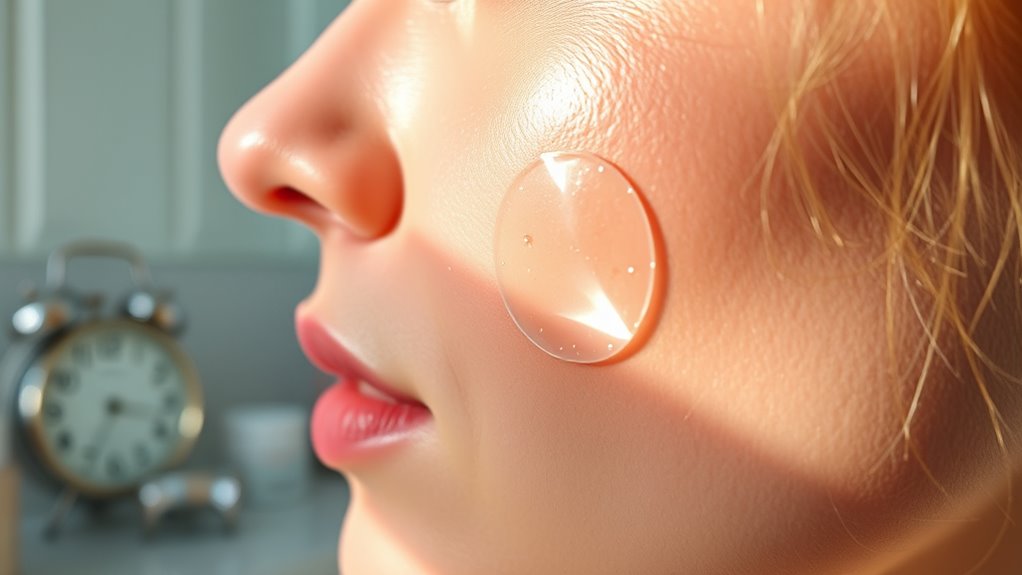
While various factors can influence how long you should leave a pimple patch on, understanding your specific skin type and the nature of your acne is essential. Generally, most hydrocolloid patches work best when left on for 6 to 8 hours, with some users opting for overnight wear of 8 to 12 hours. If you have sensitive skin, consider shorter durations of 4 to 6 hours to prevent irritation. The type of acne also plays a role; whiteheads may need the full duration, while early-stage pimples can require less time. Finally, the patch’s composition matters; those infused with active ingredients might need shorter wear times, while hydrocolloid patches are great for longer use, absorbing excess fluid effectively. Hydrocolloid patches are particularly effective on whiteheads, the final stage of a pimple’s life cycle.
How to Properly Remove a Pimple Patch
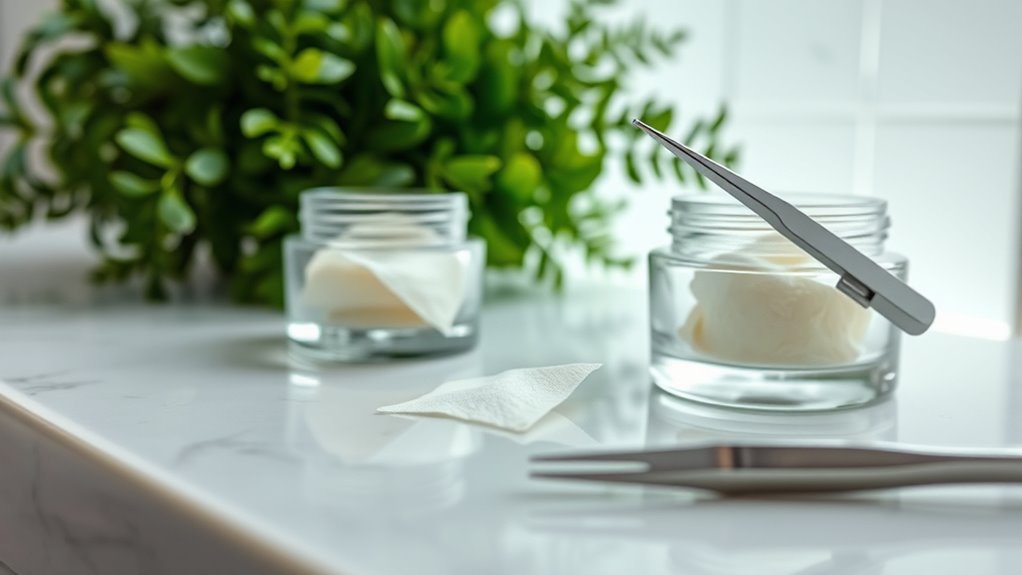
To effectively remove a pimple patch, start by checking its appearance; it should have turned opaque or white, signaling that it’s absorbed impurities. Typically, you’ll want to leave it on for 4-8 hours, but severe cases can require up to 24 hours. Gently peel the patch off from the edges to avoid irritating your skin and causing micro-tears. Confirm your hands are clean to prevent introducing bacteria. If necessary, use tweezers to avoid direct contact with the pimple. Avoid forcing the patch off, as this can lead to irritation. After removal, cleanse the area with a mild cleanser and apply moisturizer to soothe your skin. Hydrocolloid patches can help calm sudden acne and breakouts, making them an effective choice for localized treatment. If needed, you can reapply another patch for continued treatment.
Safety and Precautions to Consider

When using pimple patches, it’s important to take into account safety and precautions to confirm they work effectively and don’t cause irritation.
Always test a small area of your skin first to check for allergies before full use. If you have oily skin, make sure your skin is clean and dry for better adhesion. Additionally, using patches made from hydrocolloid material can enhance their effectiveness in absorbing excess fluid.
For sensitive skin, consider shorter wear times to avoid irritation. Be mindful of the active ingredients in the patches; they can aid healing but may cause redness if overused.
Avoid layering products under the patch, and change it daily for the best results. Finally, keep your hands clean during application and removal to prevent contamination.
Customizing Patch Use for Your Skin Type

Customizing your use of pimple patches based on your skin type can greatly enhance their effectiveness.
Tailoring pimple patch usage to your skin type significantly boosts their effectiveness.
If you have oily skin, pre-cleansing your face can help the patches stick better. For dry skin, patches can keep the area moist, boosting their impact. Additionally, hydrocolloid patches work well for absorbing excess fluid and reducing inflammation. Combination skin may need a bit of trial and error to find the right application routine. If you have sensitive skin, steer clear of microneedle patches to avoid irritation.
Always apply patches on clean, dry skin to improve adhesion and effectiveness.
Remember, hydrocolloid patches work well for whiteheads in 4-8 hours, while medicated patches for blackheads may need longer.
Tailoring your approach guarantees you get the most out of your pimple patches.
Monitoring and Replacing Pimple Patches
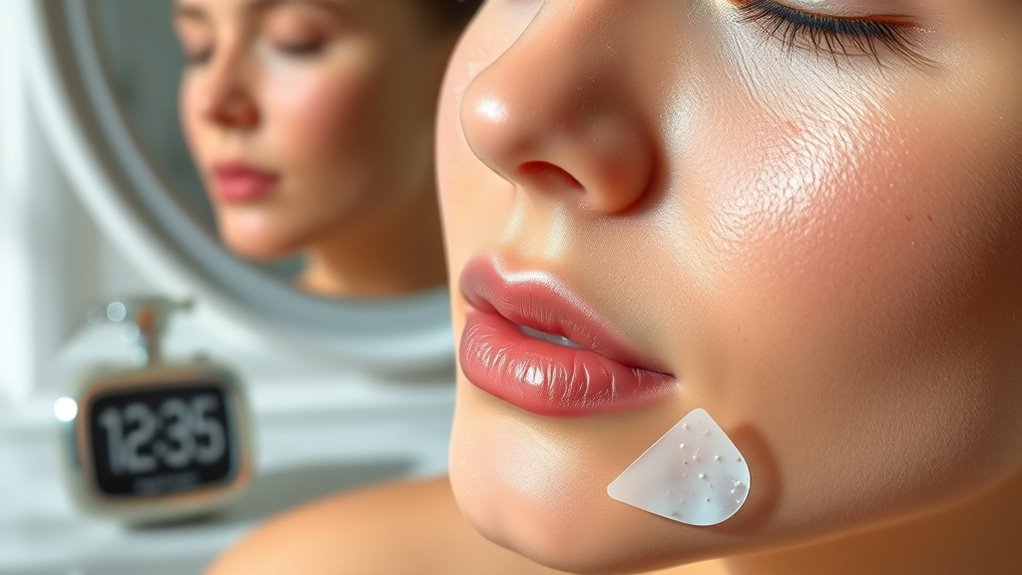
While using pimple patches can be an effective way to manage breakouts, monitoring their performance is essential for achieving the best results.
Ideally, keep patches on for 6 to 12 hours to fully absorb impurities. You’ll know a patch is saturated when it turns white or cloudy, indicating it’s time to replace it. If a patch starts peeling off, it’s lost its adhesion and effectiveness—swap it for a fresh one. Hydrocolloid patches work best on late-stage pimples as they are designed to absorb excess fluid and promote faster healing.
You can reapply patches as needed until the pimple heals, but be mindful of any irritation, especially if you have sensitive skin.
For stubborn blemishes, consider leaving patches on for up to 24 hours, ensuring your skin remains clean and dry for maximum adhesion.
Frequently Asked Questions
Can I Use a Pimple Patch on an Open Wound?
You shouldn’t use a pimple patch on an open wound.
While pimple patches are great for absorbing drainage and protecting inflamed pimples, they’re not designed for actual wounds.
If the skin is broken or infected, it’s best to seek medical advice instead.
Using a pimple patch might irritate the area and impede proper healing.
Always prioritize a clean and safe environment for any skin concerns you have.
How Do I Know if a Patch Has Expired?
So, you think your pimple patch is invincible? Think again!
To check if it’s expired, look for any visual changes—if it’s gone all cloudy or white, it’s time to say goodbye. If the edges are peeling off, that’s another red flag.
And if you catch a whiff of something sour, run! Proper storage is key, so keep those patches cool and dry to avoid premature aging.
Your skin deserves better!
Can I Apply Makeup Over a Pimple Patch?
Yes, you can absolutely apply makeup over a pimple patch!
Just make sure your skin’s clean and dry before applying the patch. Use lightweight, matte-finish products to blend seamlessly and avoid overapplying to keep the patch from standing out.
Hydrocolloid patches won’t compromise their effectiveness under makeup; they protect your pimple from clogging and environmental irritants.
Just remember, be gentle during application to maintain the patch’s adhesion!
Are Pimple Patches Safe for All Skin Types?
You might worry that pimple patches could irritate your skin, but they’re generally safe for most skin types.
Designed with hydrocolloid materials, they work well on normal, oily, dry, and sensitive skin. Just make sure to check ingredients if you’re pregnant and avoid using them on sunburned or irritated areas.
Testing a small patch first can help you avoid any reactions. Overall, they offer a protective barrier while tackling pesky breakouts.
What Should I Do if a Patch Irritates My Skin?
If a patch irritates your skin, remove it gently and slowly from the edges to minimize discomfort.
Consider switching to patches with soothing ingredients, especially if you have sensitive skin.
After removal, use a gentle moisturizer to hydrate and calm your skin.
Avoid harsh products like exfoliants for a few days.
If irritation persists, it’s best to consult a dermatologist for tailored advice and alternative treatment options that suit your skin type.
Conclusion
So, how long should you really leave that pimple patch on? It turns out, most experts recommend anywhere from six to eight hours for ideal results. But if you’re feeling adventurous, trying an overnight wear can work wonders too! Just remember, everyone’s skin is different, so pay attention to how your skin reacts. Trust your instincts—if a patch feels uncomfortable, it’s time to remove it. Your skin deserves the best care, so experiment and find what works for you!
